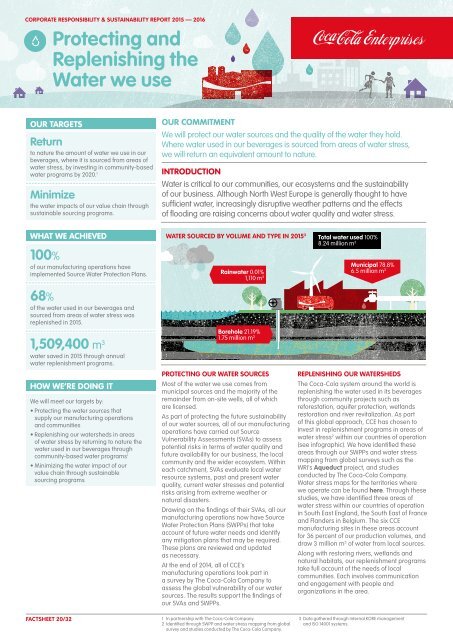Corporate Responsibility & Sustainability Report 2015/2016
1XlqBpD
1XlqBpD
Create successful ePaper yourself
Turn your PDF publications into a flip-book with our unique Google optimized e-Paper software.
CORPORATE RESPONSIBILITY & SUSTAINABILITY REPORT <strong>2015</strong> — <strong>2016</strong><br />
Protecting and<br />
Replenishing the<br />
Water we use<br />
OUR TARGETS<br />
Return<br />
to nature the amount of water we use in our<br />
beverages, where it is sourced from areas of<br />
water stress, by investing in community-based<br />
water programs by 2020. 1<br />
Minimize<br />
the water impacts of our value chain through<br />
sustainable sourcing programs.<br />
OUR COMMITMENT<br />
We will protect our water sources and the quality of the water they hold.<br />
Where water used in our beverages is sourced from areas of water stress,<br />
we will return an equivalent amount to nature.<br />
INTRODUCTION<br />
Water is critical to our communities, our ecosystems and the sustainability<br />
of our business. Although North West Europe is generally thought to have<br />
sufficient water, increasingly disruptive weather patterns and the effects<br />
of flooding are raising concerns about water quality and water stress.<br />
WHAT WE ACHIEVED<br />
100%<br />
of our manufacturing operations have<br />
implemented Source Water Protection Plans.<br />
WATER SOURCED BY VOLUME AND TYPE IN <strong>2015</strong> 3<br />
Rainwater 0.01%<br />
1,110 m 3<br />
Total water used 100%<br />
8.24 million m 3<br />
Municipal 78.8%<br />
6.5 million m 3<br />
68%<br />
of the water used in our beverages and<br />
sourced from areas of water stress was<br />
replenished in <strong>2015</strong>.<br />
1,509,400 m 3<br />
water saved in <strong>2015</strong> through annual<br />
water replenishment programs.<br />
HOW WE’RE DOING IT<br />
We will meet our targets by:<br />
• Protecting the water sources that<br />
supply our manufacturing operations<br />
and communities<br />
• Replenishing our watersheds in areas<br />
of water stress by returning to nature the<br />
water used in our beverages through<br />
community-based water programs 1<br />
• Minimizing the water impact of our<br />
value chain through sustainable<br />
sourcing programs<br />
Borehole 21.19%<br />
1.75 million m 3<br />
PROTECTING OUR WATER SOURCES<br />
Most of the water we use comes from<br />
municipal sources and the majority of the<br />
remainder from on-site wells, all of which<br />
are licensed.<br />
As part of protecting the future sustainability<br />
of our water sources, all of our manufacturing<br />
operations have carried out Source<br />
Vulnerability Assessments (SVAs) to assess<br />
potential risks in terms of water quality and<br />
future availability for our business, the local<br />
community and the wider ecosystem. Within<br />
each catchment, SVAs evaluate local water<br />
resource systems, past and present water<br />
quality, current water stresses and potential<br />
risks arising from extreme weather or<br />
natural disasters.<br />
Drawing on the findings of their SVAs, all our<br />
manufacturing operations now have Source<br />
Water Protection Plans (SWPPs) that take<br />
account of future water needs and identify<br />
any mitigation plans that may be required.<br />
These plans are reviewed and updated<br />
as necessary.<br />
At the end of 2014, all of CCE's<br />
manufacturing operations took part in<br />
a survey by The Coca-Cola Company to<br />
assess the global vulnerability of our water<br />
sources. The results support the findings of<br />
our SVAs and SWPPs.<br />
REPLENISHING OUR WATERSHEDS<br />
The Coca-Cola system around the world is<br />
replenishing the water used in its beverages<br />
through community projects such as<br />
reforestation, aquifer protection, wetlands<br />
restoration and river revitalization. As part<br />
of this global approach, CCE has chosen to<br />
invest in replenishment programs in areas of<br />
water stress 2 within our countries of operation<br />
(see infographic). We have identified these<br />
areas through our SWPPs and water stress<br />
mapping from global surveys such as the<br />
WRI's Aqueduct project, and studies<br />
conducted by The Coca-Cola Company.<br />
Water stress maps for the territories where<br />
we operate can be found here. Through these<br />
studies, we have identified three areas of<br />
water stress within our countries of operation<br />
in South East England, the South East of France<br />
and Flanders in Belgium. The six CCE<br />
manufacturing sites in these areas account<br />
for 36 percent of our production volumes, and<br />
draw 3 million m 3 of water from local sources.<br />
Along with restoring rivers, wetlands and<br />
natural habitats, our replenishment programs<br />
take full account of the needs of local<br />
communities. Each involves communication<br />
and engagement with people and<br />
organizations in the area.<br />
FACTSHEET 20/32<br />
1 In partnership with The Coca-Cola Company.<br />
2 Identified through SWPP and water stress mapping from global<br />
survey and studies conducted by The Coca-Cola Company.<br />
3 Data gathered through internal KORE management<br />
and ISO 14001 systems.


